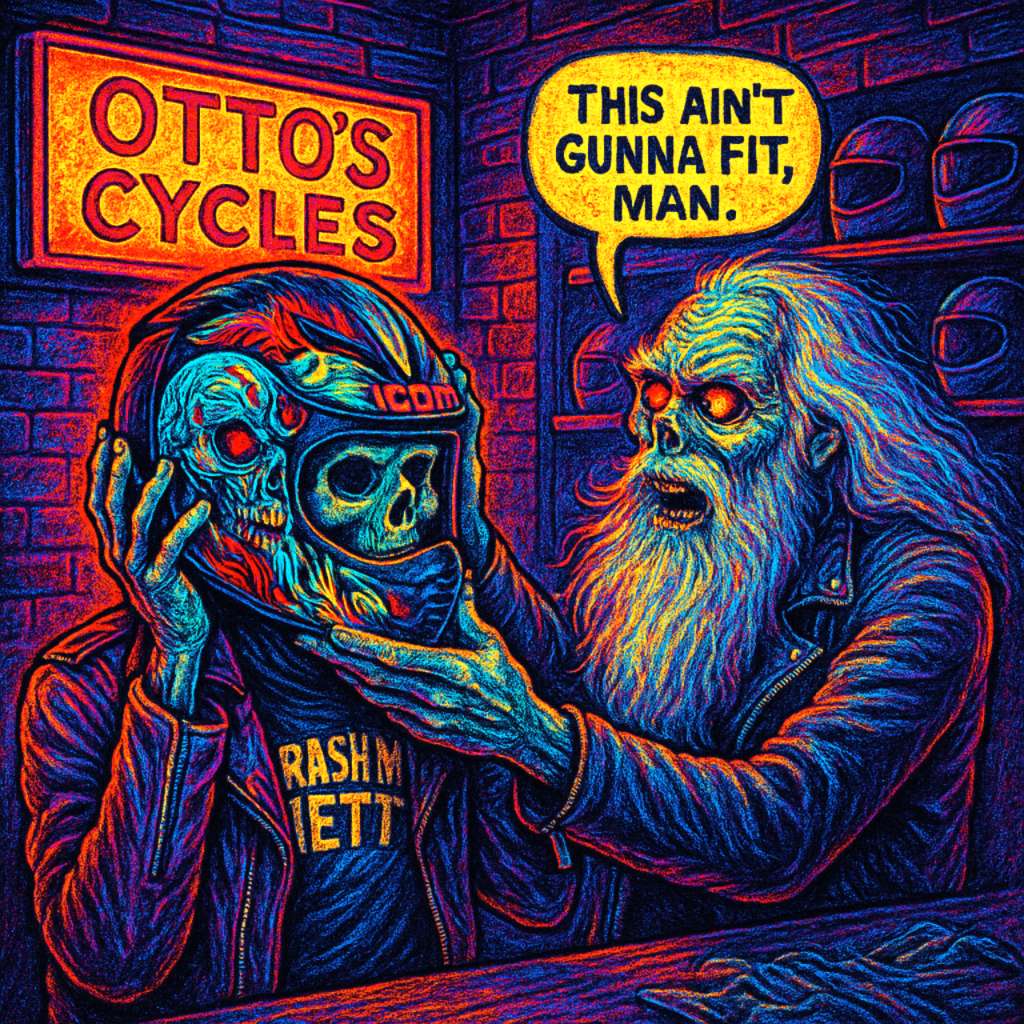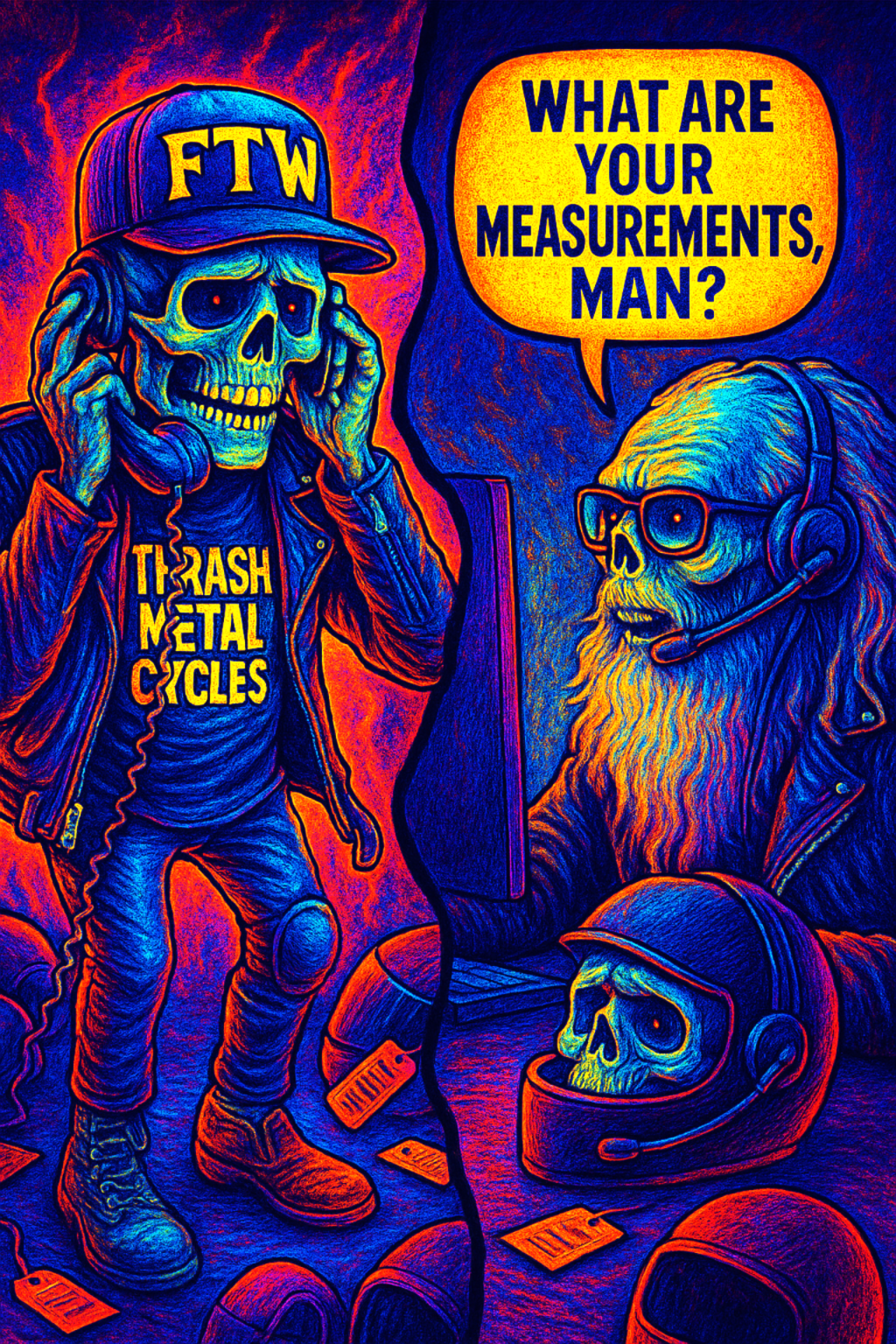How to Find the Right Gear — and Not Lose Your Mind
How to Find the Right Gear — and Not Lose Your Mind
Buying motorcycle gear should feel like gearing up for adventure — not prepping for battle. But for most riders, especially newer ones, it quickly becomes overwhelming. Sizing varies wildly, product listings are vague, and the stakes feel high when you’re about to drop hundreds of dollars on something you haven’t tried on. It’s no wonder so many riders end up frustrated, stuck in a cycle of returns, compromises, and wasted money.
The good news? It doesn’t have to be that way.
Finding gear that fits well, feels right, and protects you properly isn’t about getting lucky. It’s about timing, preparation, and a bit of detective work. So let’s walk through the process and take the stress out of suiting up.
Timing Is Everything
First and foremost, give yourself time. One of the most common and costly mistakes riders make is trying to order gear a few days before a ride. That kind of last-minute scramble forces rushed decisions, bad fitment calls, and compromises you’ll regret once you’re on the road. Even with fast shipping, delays happen. And if the gear doesn’t fit right, now you’re stuck either returning it late or riding in something uncomfortable — or unsafe.
Gear needs a break-in period, too. Gloves should move naturally with your controls. Boots need to flex where you bend. Even jackets and helmets can feel different after a few hours in the saddle. If you don’t leave room to test the gear out before the ride, you’ve taken away your own chance to get it right. The golden rule here is simple: give yourself at least two weeks, ideally a month. That’s enough time to order, receive, try on, and exchange if needed. Anything less, and you’re gambling with your comfort and safety.
Know the Fit Profiles
Once you’ve given yourself a timeline that doesn’t induce panic, the next step is understanding that sizing isn’t universal — not even close. It’s easy to assume you’re a large across the board, only to find that your usual size in one brand feels like a straightjacket in another. That’s because every brand has its own fit profile. Some cater to lean, athletic builds, while others are more relaxed and forgiving.
REV’IT! gear, for example, is well-built but usually tailored for slimmer European frames. If you’re broad-chested or have thicker arms, you may need to size up — or skip it entirely. Klim, on the other hand, designs their ADV and touring gear with a roomier cut to accommodate layers and long-haul comfort. Then there’s Street & Steel, which is all over the place. Sometimes their jackets run true to size, sometimes they’re a size too small in the sleeves and a size too large in the waist. You simply can’t rely on labels — you have to dig deeper.
Fashion Ain’t Fitment — and Style Isn’t a Brand
Here’s a hard truth riders don’t hear enough: just because it’s cool doesn’t mean it’s cool for you. You can chase that hyped-up leather jacket or mimic the style you saw in a slick promo video — but if it doesn’t fit your body, your riding style, or your lifestyle, it won’t work. Period.
There’s a difference between fashion and style. Fashion is loud. It trends. It sells. But style? Style is personal. Style fits you — physically and spiritually.
And this is where a lot of riders get stuck. They become brand fanboys. They pick a name, a logo, or an aesthetic and try to force every piece of gear to match it — even if it doesn’t fit. Even if it’s uncomfortable. Even if it’s not made for the kind of riding they actually do. That’s not style. That’s stubbornness dressed up in branding.
Being loyal to one brand or look isn’t bad — but getting myopic about it is dangerous. When your decisions are driven by loyalty instead of logic, you risk forcing bad fitment, skipping protective features, or flat-out riding in the wrong gear for the wrong job.
So respect your body. Respect your ride. Let your gear earn its place on your back — not just its spot in your Instagram feed.
Do the Homework
That’s where research becomes your best friend. You wouldn’t buy a new bike without reading reviews, watching videos, and asking around. Gear should be no different. Before you commit to anything, study the brand. What kind of rider are they building for? Is their gear cut for sport riding, commuting, or casual cruising? Are they known for generous sizing or tight fits? What’s the reputation of their armor, their stitching, or their ventilation?
Reviews, especially from people with similar body types or riding styles, are gold. Pay attention to trends in sizing feedback. If multiple riders mention that a jacket fits tight in the shoulders or gloves run long in the fingers, believe them. Use YouTube reviews to see how the gear looks in motion. Forums like ADVrider and Reddit’s r/motorcycles offer honest, no-fluff experiences from real-world riders. And don’t ignore the Q&A sections on retail sites — often the best fitment details come from other customers answering each other’s questions.
As you research, start creating your own fit profile. What size fits you in Icon? How did that Alpinestars jacket compare to the Sedici you tried? Keep notes. Build a mental (or digital) database of what works for your body. Over time, you’ll spend less energy guessing and more time riding in gear that actually fits.
Real Fitment Fails (and What They Teach Us)
Every rider has a gear horror story. Miguel once ordered a “true to size” mesh jacket two days before a summer road trip — the sleeves fit like shrink-wrap, and the vents dumped air directly into his armpits. Try 300 miles of that.
Another rider we know bought race gloves that felt perfect off the bike. But once he started reaching for the clutch after 10 minutes of real-world use, the stitching across the palm dug in like barbed wire. Three blisters later, those gloves were retired early.
Even helmets — which are often the most carefully considered piece of gear — can throw curveballs. A Shoei that felt snug in the showroom might give you a pounding pressure point at the back of your head after 30 minutes of freeway wind buffeting.
All of these stories have one thing in common: rushed decisions without enough break-in time or research. They also prove that the perfect fit doesn’t always happen on the first try — and that’s okay if you’ve planned for it.
So… what should you do?
Don’t ride in new gear until you’re sure you’re keeping it. Once gear has been worn outside or shows signs of use, it’s yours. You can’t return it. That’s why your first test should happen in your garage, on your bike, in riding position — but not in motion. Sit on the bike in full gear. Grip the bars. Reach for your levers. Turn your head left and right. Mimic the movements you’d make during a real ride. If anything pinches, pulls, or restricts your range of motion, that’s a red flag.
Try it on with your layers. Try it with your backpack or hydration pack. Try it with your helmet and gloves on at the same time. This is your one shot to assess comfort and functionality before you commit.
A little time in the garage can save a lot of pain on the road — and protect your return window, too.
Return Policies Are Your Safety Net
Even the best gear might not feel great right out of the box. That’s why return policies matter. Stick with retailers that make it easy to exchange sizes or send something back without fees or hassle. This gives you the freedom to try gear on at home, on your bike, in your garage, with your helmet and gloves on — the way it was meant to be tested.
If you’re between sizes, order both. Try them on side-by-side, test them in riding posture, and return the one that doesn’t make the cut. You’ll save time — and probably a lot of swearing — in the long run.
What to Do When Nothing Fits Right
Sometimes you’ll do everything right — measure carefully, read reviews, compare sizing charts — and the gear still won’t fit. Maybe your torso’s too long. Maybe your calves are too big for tall boots. Maybe you’ve got a shorter inseam than most pants are designed for.
Here’s what to do:
Start looking at modular brands or gear lines that offer short, tall, or big-and-tall sizing options. REV’IT!, Klim, Firstgear, and even some Sedici lines now offer “short” or “tall” lengths for jackets and pants.
If boots never fit, look into wide-width or adjustable calf options like Forma or TCX. Some brands offer swappable insoles and adjustable buckles that let you customize the internal shape.
When it comes to jackets, look for adjustability — waist straps, sleeve cinches, gusseted shoulders. A good adjustment system can turn an okay fit into a great one.
Finally, don’t be afraid to call or chat with a gear expert. RevZilla, Cycle Gear, and J&P Cycles all offer real-time help, and the folks behind the screen usually know the product lines inside and out. Tell them your riding style, body type, and what hasn’t worked — and they’ll steer you in the right direction.
Final Word: You Deserve Gear That Works
Ultimately, the gear you wear should feel like it belongs to you. It should move with you, protect you, and match your riding style. You shouldn’t have to suffer through trial and error every time you want to try something new. With the right timing, a little research, and the willingness to ask questions, you can skip the frustration and actually enjoy the process of gearing up.
No more guessing. No more compromises. Just gear that works — because you did your homework, gave yourself time, and stayed in control.
So take your time. Read the reviews. Ask the questions. Build your fit profile. And ride out knowing that what you’re wearing isn’t just good enough — it’s built for you.




